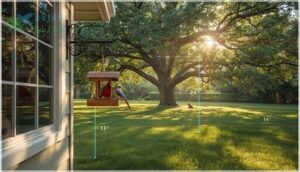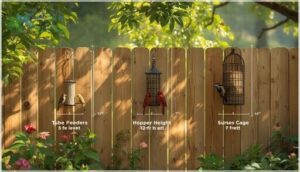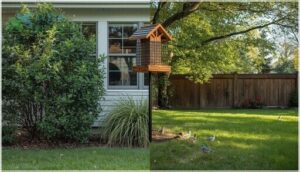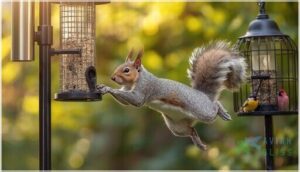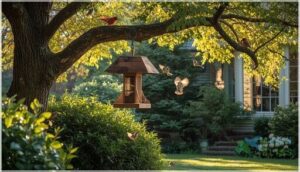This site is supported by our readers. We may earn a commission, at no cost to you, if you purchase through links.
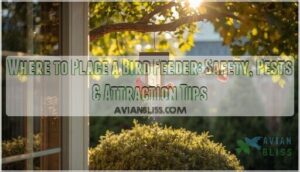
Last spring, a cardinal slammed into my kitchen window so hard it left a perfect dust outline of its wings. The feeder hanging just five feet away had turned into an accidental death trap. Over a billion birds die from window strikes in the U.S. each year, and poor feeder placement is often the culprit.
But moving that feeder to within three feet of the glass cut collisions at my house to zero. The difference between a thriving backyard habitat and a hazard zone often comes down to just a few feet.
Getting the location right means thinking like a bird—weighing safety from predators against access to food, balancing visibility with shelter, and outsmarting squirrels without sacrificing convenience. Small adjustments in where you position your feeder can transform your yard into a safe haven that attracts dozens of species while keeping them healthy and coming back.
Table Of Contents
- Key Takeaways
- Where to Place a Bird Feeder
- Ensuring Bird Safety at Your Feeder
- Keeping Squirrels and Pests Away
- Attracting More Birds With Smart Placement
- Maintaining a Healthy Bird Feeding Area
- Frequently Asked Questions (FAQs)
- Where to put bird feeders?
- Where should a bird feeder be hung?
- How do I attract birds to my feeders?
- How to set up a bird feeder?
- Where should you put a bird feeder for woodpeckers?
- Where to hang bird feeders on a deck?
- How far from the house should the bird feeder be?
- Should bird feeders be in the sun or shade?
- How far away from a window should a bird feeder be?
- Where should I put my bird feeder in my yard?
- Conclusion
Key Takeaways
- Place your bird feeder within three feet of windows or beyond 30 feet to prevent deadly collisions, since the danger zone between 5 and 33 feet causes most bird strikes.
- Position feeders 10 to 15 feet from trees or shrubs to balance quick escape routes with predator safety, while keeping them at least 10 feet from any point where squirrels can jump.
- Hang most feeders at 5 to 6 feet high for easy access and maintenance while attracting the widest variety of backyard birds like cardinals and finches.
- Clean your feeder weekly with diluted bleach solution to cut disease transmission by over 60 percent and keep your feathered visitors healthy and coming back.
Where to Place a Bird Feeder
Finding the right spot for your bird feeder makes all the difference in keeping your feathered visitors safe and happy. You’ll want to think about how far it sits from windows and trees, how high off the ground it should be, and whether you can reach it easily when it’s time to clean or refill.
Let’s walk through the key placement factors that’ll help you create the perfect feeding station.
Ideal Distance From Windows and Trees
Placing your feeder at the right distance from windows and trees transforms your backyard into a safe bird haven. Window collisions kill millions of birds yearly, but smart safe bird feeder placement prevents tragedy. Here’s what works:
- Keep feeders within 3 feet of windows to reduce Collision Risk Zones
- Position 10-12 feet from trees for Shelter Proximity Benefits without creating Predator Ambush Points
- Stay beyond Squirrel Jump Range (10+ feet from launch points)
This balance ensures Visibility vs. Safety while preventing window collisions. To attract a wider variety of birds, consider multiple feeding stations.
Height Recommendations for Different Feeders
Once you’ve nailed the distance, best feeder height matters just as much. Different feeders work best at specific heights. Tube feeders and hopper feeders should hang 5-6 feet high for species-specific heights that attract finches and cardinals while keeping predator avoidance in mind. Suet feeders go slightly higher at 5-7 feet for woodpeckers.
The ideal height range for most backyard birds is 5-6 feet. This safe feeder placement balances maintenance access with what birds naturally prefer.
Accessibility for Refilling and Cleaning
Height matters for birds but also for you. Smart feeder placement means easy refilling and cleaning frequency without a ladder. Position feeders 4-6 feet high within arm’s reach of a path or deck for safe maintenance.
Here’s what makes maintaining bird feeding stations simple:
- Place feeders near convenient access points for quick seed storage runs
- Choose locations with good lighting to spot dirty ports during tool selection
- Allow space around feeders to work comfortably during your time investment
Regular seed feeder maintenance keeps birds healthy and visiting.
Ensuring Bird Safety at Your Feeder
Your feeder setup can make all the difference between a safe haven and a danger zone for visiting birds. Even well-meaning bird lovers sometimes place feeders in spots that put their feathered friends at risk.
Let’s look at three key safety concerns you need to address to protect the birds that visit your yard.
Preventing Window Collisions
Window strikes kill over a billion birds each year in the U.S. You can help prevent window collisions by placing feeders within three feet of windows or more than ten feet away. Birds flying from closer feeders hit glass at slower speeds, which reduces collision mortality.
To prevent deadly window strikes, place bird feeders within three feet of glass or beyond ten feet away
Visual deterrents like decals or tape spaced two inches apart help birds recognize glass as a barrier and improve window safety.
Providing Shelter and Protection
When birds feel safe, they’ll visit your feeder more often. Position feeders within eight feet of dense trees or shrubs so birds have quick escape routes from predators. Native evergreens provide excellent year-round natural cover and weather protection.
You can also add artificial shelters like roosting boxes or simple brush piles nearby. This combination of natural shelter and predator protection creates a welcoming environment that keeps your feathered friends coming back.
Safe Distances From Predators
Beyond shelter alone, strategic feeder placement protects birds from predators while letting them feed safely. Position feeders 10 to 15 feet from protective cover to balance escape routes with danger zone management—closer distances let ground predators ambush feeding birds.
Mount feeders 5 to 6 feet high to deter ground predator attacks. This combination reduces hawk predation risk and keeps avian predators from turning your yard into a hunting ground.
Keeping Squirrels and Pests Away
Squirrels can be some of the most persistent visitors to your bird feeder. They’re talented acrobats that can jump up to 10 feet horizontally and shimmy up poles in seconds.
Let’s look at three practical ways to keep these clever critters from stealing all your birdseed.
Minimum Distance From Jump-Off Points
Squirrels are natural acrobats that can leap up to 10 feet horizontally from trees, shrubs, and roofs. You’ll want to position your feeder at least 10 feet away from any jump-off point. This includes branches, utility wires, and deck railings.
For extra protection, add a couple feet beyond this minimum. Proper feeder pole spacing keeps these clever raiders grounded while birds enjoy safe shelter and perching areas nearby.
Squirrel Baffles and Deterrents
Even the best jump-proof placement won’t always stop determined squirrels. That’s where baffles shine as your front-line defense.
- Dome-shaped baffles mounted above hanging feeders work well when paired with a second baffle below for near 100% effectiveness
- Cylindrical pole baffles placed at least 5 feet high block climbers almost completely
- Metal designs resist chewing and weather better than plastic
- Raccoon baffles offer extra length for larger pests
Proper installation transforms squirrel-proofing bird feeders from frustrating to functional.
Choosing Squirrel-Resistant Feeders
When baffles aren’t enough, weight-activated feeders step in as your definitive solution. These designs close seed ports under squirrel weight while welcoming smaller birds. Metal construction prevents chewing damage and extends feeder longevity.
Market trends show growing demand for durable squirrel-resistant models. User perceptions confirm these feeders dramatically reduce refills and stress. Design features like caged openings keep deterring squirrels and raccoons effectively for years.
Attracting More Birds With Smart Placement
You’ve already tackled safety and squirrels. Now it’s time to roll out the welcome mat for your feathered guests. The right placement doesn’t just keep birds safe—it makes your feeder impossible to resist.
Let’s look at three smart strategies that’ll turn your yard into the neighborhood hotspot for birds.
Visibility for Birds and Bird Watchers
Think of your bird feeders as tiny stages. You want clear sightlines so birds can spot food easily and watch for danger. Place feeders where window reflections won’t confuse them or cause hesitation.
Position them near natural cover but in the open enough for great bird watching from your favorite spot.
As seasonal changes shift light and foliage, adjust placement to keep attracting birds to feeders and backyard birds visible year-round.
Catering to Different Bird Species
Once you know birds can spot your feeder, it’s time to think about their feeding habits. Different avian species have unique preferences. Platform feeders attract about 92% of bird species, including cardinals and doves. Ground-dwelling birds like sparrows prefer feeders 1 to 5 feet high. Here’s what works:
- Cardinals and finches thrive at 5 to 6 feet
- Woodpeckers need suet at 6 to 10 feet
- Bluebirds favor open areas at 5 to 7 feet
- Ground feeders suit doves and juncos best
- Shelter proximity (12-15 feet from trees) helps most species feel safe
Match feeder type and height to the birds you’re hoping to see.
Using Landscaping to Enhance Feeder Appeal
You can make your yard more welcoming by weaving native shrubs and bird-friendly plants near your feeder. Native trees and flowering vines create natural perches and shelter landscaping that birds trust.
Add stone borders or mulch underneath to manage spillage and give your space visual enhancements. This approach promotes seasonal suitability while helping with pest management. You’re creating bird-friendly habitats that truly work.
Maintaining a Healthy Bird Feeding Area
A clean feeder is a healthy feeder. Birds can get sick from moldy seed or contaminated feeding areas just like we can from a dirty kitchen.
Let’s look at simple ways to keep your feeding station safe and welcoming for your feathered friends.
Managing Seed Spillage and Cleanliness
Keeping the area beneath your feeder tidy protects both birds and your backyard. Seed catcher trays installed under feeders catch most falling bird food before it hits the ground. Regular cleaning prevents environmental impact like unwanted seed dispersal and rodent control problems.
Try these feeding practices:
- Use no-grow seed mixes to stop weeds from sprouting
- Fill feeders with only 1-2 days’ worth of seed
- Sweep debris weekly to reduce mold growth
- Choose feeders with built-in seed guards
Avoiding Mold and Contamination
Moisture is the real culprit behind mold growth in bird feeders. Position yours where rain won’t pool inside and air flows freely for better Seed Moisture Control. Damp seed develops fungal spores within 48 hours—harmful to visiting birds.
Choosing well-ventilated Feeder Material Impact designs and using moisture-absorbing products like Feeder Fresh keeps contents dry.
During humid weather, minimizing mold and mildew growth means filling feeders with smaller portions you’ll replace more frequently.
Regular Feeder Maintenance and Observation
Weekly cleaning cuts disease transmission by over 60%. Watch for health indicators like swollen eyes or lethargic behavior during observation—early detection prevents outbreaks from spreading.
Maintaining bird feeding stations means scrubbing with diluted bleach solution and rinsing thoroughly. This hygiene impact directly improves bird behavior and feeding patterns you’ll notice.
Your bird watching enjoyment grows when visitors stay healthy and return regularly.
Frequently Asked Questions (FAQs)
Where to put bird feeders?
You’ll want to choose bird feeder placement considerations carefully.
Positioning bird feeders for safety means finding that sweet spot where feeder location balances visibility, protection, and accessibility while keeping both birds and squirrels in mind.
Where should a bird feeder be hung?
Hang your feeder at the best height of 5 to 6 feet. Choose a location with sun exposure and wind protection near a tree branch. Position it where birds have vantage points and clear escape routes.
How do I attract birds to my feeders?
Think of your feeder as a restaurant—birds’ feeding preferences demand diverse bird food like black-oil sunflower seeds, water source access, native plants nearby, feeder visibility, and consistent refills to master bird feeding strategies attracting backyard birds successfully.
How to set up a bird feeder?
Choose a feeder type that suits your target birds and select appropriate bird food. Install it at the right placement height with weather protection. Squirrelproofing bird feeders helps make sure your feeding station stays accessible to birds alone.
Where should you put a bird feeder for woodpeckers?
Woodpeckers prefer feeders near vertical surfaces like tree trunks at 6 to 10 feet high. Choose clinging feeder designs that mimic tree bark. Place them in quiet feeding spots away from crowded seed feeders to match their natural feeding behavior.
Where to hang bird feeders on a deck?
Your deck offers a perfect spot for bird feeders when you position them about 5 to 6 feet high, which deters squirrels while providing easy weather accessibility and an excellent viewer experience from indoors.
How far from the house should the bird feeder be?
Some folks treat bird feeders like unwelcome relatives—banished to the yard’s edge. But placing feeders within 10 feet of your house balances human convenience with bird visibility while reducing deadly window collisions.
Should bird feeders be in the sun or shade?
Partial shade works best for most bird feeders. It prevents seed spoilage and nectar fermentation while keeping birds comfortable. Microclimate effects and seasonal variation matter too—morning sun with afternoon shade balances weather conditions nicely.
How far away from a window should a bird feeder be?
Your feeder should sit within 3 feet of windows or beyond 30 feet to prevent fatal collisions. Research shows distances between 5 and 33 feet create the most dangerous collision risk zones for birds.
Where should I put my bird feeder in my yard?
Your yard is a stage where nature performs daily. Place your bird feeder where it balances sunlight exposure, wind protection, and water source proximity.
Smart yard landscaping creates a bird-friendly habitat while enhancing yard aesthetics naturally.
Conclusion
Getting where to place a bird feeder right isn’t rocket science—it’s bird science. Those few feet between your window and feeder can mean the difference between a backyard full of life and one marked by tragedy.
You’ve learned the distances that protect against collisions and predators. You know how to outsmart squirrels and attract the species you love.
Now step outside and make those adjustments. Your feathered visitors are counting on you to create a space where they can thrive safely.

